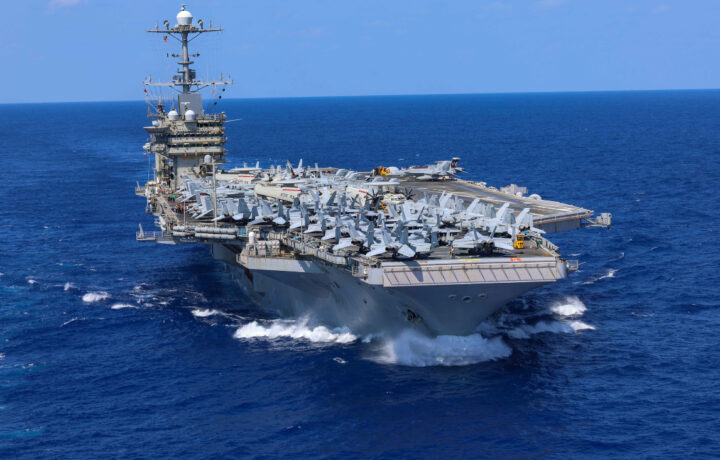On Thursday, the United States Navy released the first photos that showed the damage that the Nimitz-class nuclear-powered supercarrier USS Harry S. Truman (CVN-75) sustained after the 100,000-ton warship collided with a 53,000-ton Panamanian-flagged cargo ship while operating in the Mediterranean Sea near Port Said, Egypt.
“The Nimitz-class aircraft carrier USS Harry S. Truman (CVN 75) was involved in a collision with the merchant vessel Besiktas-M at approximately 11:46 p.m. local time, Feb. 12, while operating in the vicinity of Port Said, Egypt, in the Mediterranean Sea,” U.S. Sixth Fleet Public Affairs said in a statement. “The collision did not endanger the Harry S. Truman (CVN 75) as there are no reports of flooding or injuries. The propulsion plants are unaffected and in a safe and stable condition. The incident is under investigation. More information will be released as it becomes available.”
The U.S. Navy’s carrier departed her home port of Norfolk, VA, in September and had been operating in the Red Sea since December. Prior to the arrival in the U.S. Central Command’s (CENTCOM’s) area of responsibility, USS Harry S. Truman – named for the 33rd president – had taken part in joint operations with the Royal Norwegian Air Force (RNoAF) near the Arctic.
The United States Navy has been rotating aircraft carriers to the Middle East region since the October 7, 2023, attacks carried out by the Iranian-back Hamas into southern Israel, which sparked the war in Gaza. The Yemen-based Houthi militants, which are also backed by Tehran, then responded by targeting commercial shipping in the Suez Canal and the Red Sea. The U.S. warships deployed to the region have helped protect the maritime traffic while also seeking to deter any escalation of the conflict.
The Houthis have alleged on several occasions to have struck and damaged U.S. carriers and also claimed responsibility for downing the U.S. Navy Boeing F/A-18 Super Hornet operating from USS Harry S. Truman that was actually shot down in a friendly fire incident in December.
Where, When And How?
Numerous questions are being asked this week on how the two massive ships collided. The Nimitz-class carrier measures nearly 1,100 feet, while the bulk cargo ship Besiktas-M is around 618 feet. CVN-75 had recently concluded a port call at U.S. Naval Support Activity (NSA) Souda Bay, Greece – joined by the Arleigh Burke-class guided-missile destroyer USS Jason Dunham (DDG-109) – and was likely returning to the Red Sea.
USS Harry S. Truman is believed to have been heading south towards Port Said, which is at the north end of the Suez Canal, where it meets the Mediterranean Sea, while Besiktas-M had just transited the canal and was bound for the Romanian port of Constanta on the Black Sea.
Naval experts have said that it would be uncommon for a commercial ship to even get that close to a carrier, as its escorts in the Carrier Strike Group (CSG) are there to ensure that doesn’t happen. However, the issue is the narrowness of the Suez Canal, which is just 205 meters wide. It requires that the vessels in the CSG must travel single file.
CNN quoted former U.S. Navy captain Carl Schuster, an instructor at Hawaii Pacific University, who said, “There is not a lot of room for maneuvering in a restricted seaway and both ships require about one nautical mile to stop.”
At the time of the collision, there were around 100 ships near an anchorage off Egypt’s Port Said. It is unclear if USS Jason Dunham was with the carrier when the collision occurred.
According to a report from USNI News, the last known collision between a carrier and a merchant ship was on July 22, 2004, when the conventionally-powered USS John F. Kennedy (CV-67) collided with a small dhow in the Persian Gulf during the nighttime helicopter operations. The commander of CV-67 was relieved after an initial investigation.
There is already speculation that the captain of CVN-75 will also be relieved of command.
“He is 100% responsible for everything aboard ship—no excuses,” said John Konrad V, the CEO of the gCaptain maritime news website, in a post on X, the social media platform formerly known as Twitter.
The crew and command staff of USS Harry S. Truman has now faced two serious black eyes in just eight weeks.




